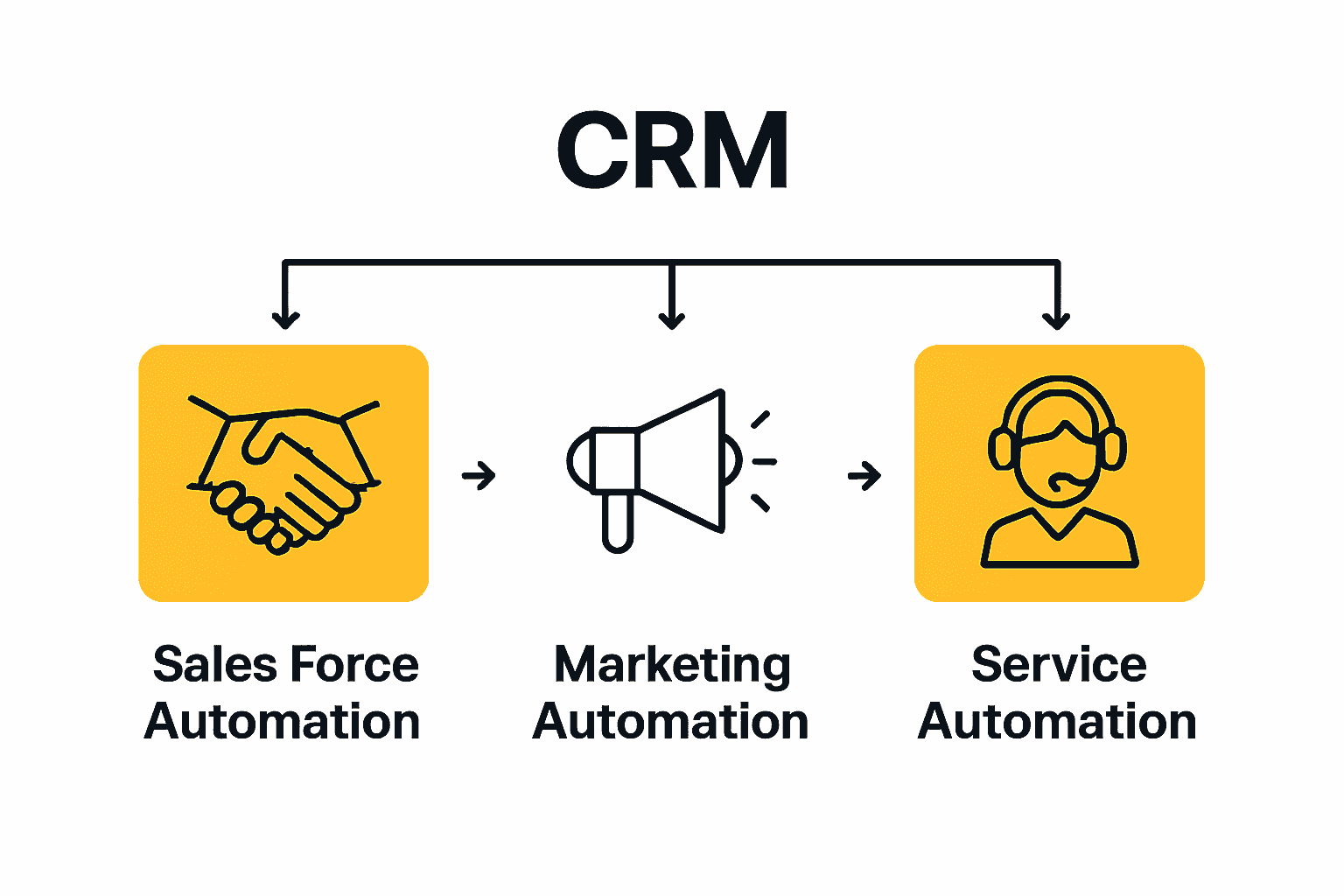Nearly 80 percent of businesses say that building strong client relationships is now their top priority. In a world where customer expectations evolve quickly, understanding the principles of client relationship management can make the difference between satisfied clients and lost opportunities. By exploring key strategies and proven approaches, you can discover practical ways to increase customer loyalty and drive lasting business success.
Table of Contents
- Defining Client Relationship Management Principles
- Types of Client Relationship Management Systems
- Core Features And Functionalities Of CRM
- Real-World Applications In Modern Businesses
- Common Pitfalls And CRM Implementation Challenges
Defining Client Relationship Management Principles
Client Relationship Management (CRM) represents a strategic approach that organizations use to manage interactions and relationships with current and potential customers. At its core, CRM is about understanding customer needs, tracking engagement, and developing targeted strategies to enhance satisfaction and loyalty.
According to research from ucc.edu.gh, CRM principles are critical across diverse sectors, extending far beyond traditional sales environments. The study highlights how systematic relationship management can significantly improve client satisfaction, particularly in service-oriented industries like healthcare and public services.
The fundamental principles of effective CRM revolve around several key dimensions:
- Data Collection: Systematically gathering comprehensive customer information
- Interaction Tracking: Monitoring all customer touchpoints and communication channels
- Personalization: Tailoring experiences and communication to individual customer preferences
- Continuous Engagement: Maintaining proactive and meaningful connections beyond transactional interactions
Arxiv research further emphasizes that integrating CRM principles with strategic cost management can help organizations understand the true economic value of customer relationships. By analyzing customer interactions through a financial lens, businesses can optimize resource allocation and develop more targeted engagement strategies.
Successful CRM is not about technology alone, but about creating a holistic approach that prioritizes customer understanding, seamless communication, and value-driven interactions. It requires commitment from every organizational level to transform customer data into meaningful relationship-building opportunities.
Types of Client Relationship Management Systems
Client Relationship Management (CRM) systems are not one-size-fits-all solutions but come in various specialized types designed to address different organizational needs and customer interaction strategies. Understanding these variations helps businesses select the most appropriate system for their unique operational requirements.
According to the encyclopedia.pub research, CRM systems can be broadly categorized into three primary types: Strategic CRM, Operational CRM, and Analytical CRM. Each type serves a distinct purpose in managing and enhancing customer relationships:
- Strategic CRM: Focuses on long-term customer relationship development and alignment with overall business strategy
- Operational CRM: Streamlines daily customer-facing processes like sales, marketing, and service interactions
- Analytical CRM: Leverages data and advanced analytics to extract insights about customer behavior and preferences
Arxiv research introduces an emerging category called CRM 2.0, which integrates Web 2.0 technologies to create more interactive and responsive customer service platforms. This modern approach emphasizes real-time communication, social media integration, and personalized digital experiences.
Modern CRM systems often blend these types, creating hybrid solutions that provide comprehensive customer relationship management.
 The goal is not just to categorize interactions but to create a seamless, intelligent ecosystem that anticipates customer needs, personalizes communication, and drives meaningful engagement across multiple touchpoints.
The goal is not just to categorize interactions but to create a seamless, intelligent ecosystem that anticipates customer needs, personalizes communication, and drives meaningful engagement across multiple touchpoints.
Core Features and Functionalities of CRM
Client Relationship Management (CRM) systems are sophisticated platforms designed to centralize, streamline, and optimize how businesses interact with and understand their customers. These systems go far beyond simple contact management, providing comprehensive tools that transform raw customer data into actionable strategic insights.
According to encyclopedia.pub, CRM systems typically encompass three core functional domains:
- Sales Force Automation: Tracking leads, managing sales pipelines, and monitoring customer interactions
- Marketing Automation: Creating targeted campaigns, segmenting audiences, and measuring marketing effectiveness
- Service Automation: Managing customer support tickets, tracking service requests, and maintaining comprehensive interaction histories
Arxiv research highlights an emerging trend of advanced CRM functionalities, including autonomous control mechanisms that leverage deep reinforcement learning to predict customer behaviors. These sophisticated systems can now approximate customer lifetime value and recommend optimal marketing actions with unprecedented precision.
The most powerful CRM systems integrate multiple features to create a holistic view of customer relationships. This includes contact management, interaction tracking, communication logging, performance analytics, and predictive modeling. By consolidating information from various touchpoints, these systems enable businesses to develop more personalized, responsive, and strategic approaches to customer engagement.

Real-World Applications in Modern Businesses
Client Relationship Management (CRM) has transcended its original conception as a mere sales tracking tool, emerging as a critical strategic asset across diverse industries and organizational contexts. Modern businesses leverage CRM systems to transform complex customer interactions into meaningful, data-driven relationship-building opportunities.
Research from ucc.edu.gh provides a compelling example in public services, specifically highlighting how the National Health Insurance Scheme in Ghana utilized CRM principles to dramatically enhance client satisfaction. This demonstrates that CRM’s potential extends far beyond traditional commercial environments, offering substantial improvements in service delivery and customer experience across sectors.
Key real-world applications of CRM systems include:
- Healthcare Management: Tracking patient interactions, managing appointment scheduling, and personalizing care experiences
- Financial Services: Monitoring customer financial profiles, predicting investment needs, and customizing product recommendations
- Retail: Managing customer purchase histories, creating targeted marketing campaigns, and developing loyalty programs
- Professional Services: Tracking client communications, managing project interactions, and optimizing relationship maintenance
Arxiv research further illustrates the evolution of CRM through CRM 2.0 technologies, which enable more interactive and responsive customer service platforms. These advanced systems integrate social media channels, real-time communication tools, and sophisticated data analytics to create unprecedented levels of personalized customer engagement.
Ultimately, successful CRM implementation is about more than technological implementation it’s about cultivating a customer-centric organizational culture that prioritizes understanding, anticipating, and exceeding customer expectations across every interaction point.
Common Pitfalls and CRM Implementation Challenges
Implementing a Customer Relationship Management (CRM) system is rarely a straightforward process. While these platforms promise transformative capabilities, organizations frequently encounter complex obstacles that can derail successful adoption and integration.
Arxiv research reveals critical challenges in CRM implementation, particularly the difficulty of accurately determining customer service costs and aligning CRM strategies with overarching organizational objectives. These strategic misalignments can significantly impede the system’s potential value and effectiveness.
Common implementation challenges include:
- Data Quality Issues: Incomplete, inconsistent, or outdated customer information
- User Resistance: Employees reluctant to adopt new technological platforms
- Integration Complexity: Difficulties connecting CRM with existing organizational systems
- Cost Management: Unexpected expenses and resource allocation challenges
- Training Gaps: Insufficient skill development for effective system utilization
Arxiv research further highlights the intricate dynamics of implementing advanced CRM technologies, especially when integrating Web 2.0 technologies that require managing dynamic and complex interaction environments. The research emphasizes that successful implementation goes beyond technical configuration and demands a holistic organizational approach.
Ultimately, overcoming CRM implementation challenges requires a strategic, patient approach that prioritizes comprehensive change management, continuous training, and a culture of technological adaptability. Organizations must view CRM not as a one-time technological investment, but as an ongoing process of relationship management and continuous improvement.
Transform Your Client Relationship Management With Smarter Tools
Managing customer data, personalizing communications, and tracking every interaction can overwhelm even the best teams. The article highlights common CRM pain points such as data quality issues, user resistance, and integration challenges. If you want to move beyond these obstacles and build true customer loyalty through automation and seamless team coordination, the right platform can make all the difference.
Gammatica.com is a powerful SaaS-based solution designed to streamline your CRM processes while enhancing overall project and team management. With AI-driven automation, task management, and intuitive workflows like Kanban boards, you can reduce administrative burdens and consistently deliver personalized customer journeys. Imagine freeing up to 16 hours each week to focus on what matters most: building lasting client relationships and growing your business.

Ready to overcome CRM implementation challenges and elevate your client management strategies? Visit Gammatica.com to explore how AI-powered automation and collaboration tools can transform your workflows. Take control of your customer relationships today and experience streamlined business operations, smarter data handling, and improved team productivity at Gammatica.com. Your next-level CRM journey starts now.
Frequently Asked Questions
What are the core principles of Client Relationship Management?
The core principles of Client Relationship Management (CRM) include data collection, interaction tracking, personalization, and continuous engagement. These dimensions help organizations understand customer needs and enhance satisfaction.
What types of CRM systems are available?
CRM systems can be broadly categorized into Strategic CRM, Operational CRM, and Analytical CRM. Each type serves unique purposes, such as developing long-term relationships, streamlining daily processes, and leveraging data for insights.
What are the main features of CRM systems?
Key features of CRM systems typically encompass Sales Force Automation, Marketing Automation, and Service Automation. These functionalities help businesses track customer interactions and optimize engagement strategies effectively.
What are common challenges encountered during CRM implementation?
Common challenges during CRM implementation include data quality issues, user resistance, integration complexity, cost management, and training gaps. Addressing these challenges is crucial for the successful adoption of a CRM system.



